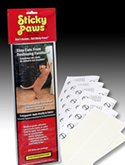|
Cat Declawing, The Truth That Every Cat Lover Needs To KnowThis page is about cat declawing. It is a sad and frightening subject but one that I feel needs to be addressed. Please, if you are considering declawing your cat, take just a few minutes and read this. It will give you valuable information that you may not know, which will help you in making your decision.
Is Declawing Inhumane?In a word – yes. One thing you may not know is that cat declawing is a practice mostly limited to America and Canada. It's something that some people do for their own convenience. The fact is, most of the people who do it are well meaning cat owners who never realize what a torturous ordeal they are putting their loving cat through, or that the cat may never recover fully from the physical and emotional trauma of a declawing procedure. In many European countries cat declawing is termed "inhumane" and "unnecessary mutilation”, and is illegal. I wholeheartedly agree.
So you can see that all these countries have let it be known that they will not tolerate regular mutilation of cats for the convenience of the owner. It is my fervent hope that we here in the USA and Canada will join this list soon.
What You Need to KnowBefore you make any decision regarding declawing your cat, there is some important information that you need to know. Cat declawing is not like a manicure. It is serious surgery. Your cat's claw is not a toenail like you and I have. More like the last bit of our fingers, a cat’s claw is actually closely connected to the bone. The claw is so closely connected that in order to remove the claw, the last bone of the cat's claw has to be removed (amputated). Declawing is actually an amputation of the last joint of each of your cat's "toes".
Of course, everyone knows that felines, being sensitive creatures (whose brains’ emotional and pain centers closely resemble our own) can suffer pain. They do tend to hide it better. Besides being proud beings, their instincts tell them to hide weakness and pain, because in the wild, that makes them terribly vulnerable to attack. But the fact that they often suffer in silence does not mean they do not suffer. They suffer far more than they will ever let you know. Cat declawing is not just a “convenience” for humans, nor is it a surgery to be taken lightly. Multiple AmputationsContrary to what most people believe, cat declawing means amputating not just the claws (not possible), but cutting the toe up to the joint, including bones, ligaments, and tendons! To remove the claw, the bone, nerve, joint, ligaments, and tendons must all be amputated. So you can see that declawing is not just a single surgery but 10 separate, painful amputations.
The same procedure, put into human terms would involve cutting each of a human’s fingers off at the first joint and then making them walk on the newly amputated digits. A cat’s body is perfectly created for their lifestyle. The stealth and grace that is “Cat” is dependent on their unique anatomy.
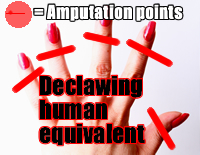
Their very balance depends on their toes, which they walk on, unlike us flat footed humans. Also, in declawing, you deprive your cat of any real defense if he should ever find himself outdoors. Yes, he still has teeth, but by the time the attacker is close enough for your cat to defend himself with his teeth, it may already be far too late for kitty. Psychological & Behavioral RamificationsSome felines are so shattered and stunned by cat declawing that their personalities actually change. Cats who were sweet natured and friendly often become standoffish and very withdrawn after being declawed. Others, upon realizing they now have virtually no defense, become skittish, nervous, afraid, and sometimes aggressive. These poor souls often wind up in shelters because now they are afraid and use their only remaining means of defense, their teeth. Another complication is that when a victim of cat declawing uses his litter box, he may very well associate his pain with the box, since scratching is now so painful, and may avoid using it, and substitute nice soft carpet instead. Not his fault, I say. He is just trying to cope with the pain. It is a sad fact that many of the cats who wind up in shelters are put there because of behavioral problems they developed only after and as a direct result of cat declawing surgery. Such cats are hard to find homes for and most wind up euthanized.
Moral, Ethical or Humane?Most veterinarians who offer cat declawing justify the procedure by saying that the owner may otherwise dispose of the cat, abandon it, or worse. I and many other cat lovers consider it absolutely wrong for veterinarians to give in to what basically amounts to moral blackmail from their clients. I will not even take my cat to a veterinarian that offers declawing.
The Cat Fancier's Association, the world's largest pedigreed cat registry, has issued a statement regarding its official position regarding cat declawing. Part of this statement is “CFA perceives the declawing of cats (onychectomy ) and the severing of digital tendons (tendonectomy) to be elective surgical procedures that are without benefit to the cat. Because of the discomfort associated with any surgery and potential future behavioral or physical effects, CFA disapproves of routine declawing or tendonectomy surgery in lieu of alternative solutions to prevent household damage.”
The Association of Veterinarians for Animal Rights (AVAR) has made the following statement; "The Association of Veterinarians for Animal Rights is opposed to cosmetic surgeries and to those performed to correct 'vices. 'Declawing generally is unacceptable because the suffering and disfigurement it causes is not offset by any benefits to the cat. Declawing is done strictly to provide convenience for people. Some veterinarians have argued that some people would have their cats killed if declawing was not an option. We should not, however, allow ourselves to taken 'emotional hostage' like this. If a person really would kill her or his cat in this case, it is reasonable to question the suitability of that person as a feline guardian, especially when there are millions of non-declawed cats living in harmony with people."

Dr. Nicholas Dodman, author of "The Cat Who Cried for Help," has this to say about cat declawing:
Partial digital amputation is so horrible that it has been employed for torture of prisoners of war, and in veterinary medicine, the clinical procedure serves as model of severe pain for testing the efficacy of analgesic drugs. Even though analgesic drugs can be used postoperatively, they rarely are, and their effects are incomplete and transient anyway, so sooner or later the pain will emerge." Alternatives to Cat DeclawingSo now that you know the horrifying truth that most vets who do this procedure won’t tell you. In fact, some may even offer to “do the claws” at the same time as a spay or neuter procedure, as if it were no more serious than those very beneficial procedures. We now know that cat declawing is nothing short of torture and hopefully you love your cat enough to not put him through that. So, what can you do instead?
You can buy inexpensive clippers at any pet store, but a good toenail clipper meant for human use will also do the job. Be careful not to cut into the dark part on the underside of the tip (the quick). This will scare your cat and cause bleeding. If you are nervous about doing this or unable to do this yourself, ask your veterinarian to show you how the first time or visit my page on
cat claw clipping
. If you can get your cat to accept or at least tolerate the humming, the new motorized rotary pet claw trimmers leave a nice smooth edge on the claw. Please, be very careful if you consider the emery type cat scratchers. I've heard from many people that their cats do not like it because of the texture, and from those whose cats who do use it, saying how often get their claws stuck in the corrugated surface causing the cat to suffer injury.
Soft Paws are fairly easy to apply (even easier with a partner to apply the glue to the caps and hand them to you) and last until your cat’s claws grow out, usually four to six weeks. They come in clear or colors. The colored caps are actually pretty and are easy to spot when one eventually falls off. Then, you can simply replace it. Please note that the caps and nail trimming should only be done on indoor cats who are not exposed to the dangers of the outdoors.
There really is no good reason today to even consider cat declawing, even as a solution for destructive scratching. Try the alternatives above, or a combination if you like, and I believe you’ll discover that it’s easier than you think to re-direct your cat’s scratching. Cat declawing truly is a barbaric and torturous practice.
Luckily, most people really do love their cats and, given a choice, want to do what's best for all concerned, especially the beloved family member with claws! So please, for the sake of your cat, your relationship with the cat and for your conscience, think carefully about the wonderful little feline who relies on you to be his guardian and who trusts you with his life and do everything in your power to never let him be subjected to this kind of pain. Please, make the humane choice and don't declaw!Back from Cat Declawing to Home Page
|
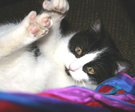
 When you envision that, you can see why cat declawing is not a humane act. It is a very painful surgery, with an equally painful recovery period. And remember that during the “recuperation” from the surgery, the poor cat still has to use its feet to jump, climb, walk and scratch in its litter box, no matter how much pain it is feeling. Bed rest and bedpans are not an option for a cat. He still has to eat, use the litter box and walk on toes which have just had the ends cut off.
When you envision that, you can see why cat declawing is not a humane act. It is a very painful surgery, with an equally painful recovery period. And remember that during the “recuperation” from the surgery, the poor cat still has to use its feet to jump, climb, walk and scratch in its litter box, no matter how much pain it is feeling. Bed rest and bedpans are not an option for a cat. He still has to eat, use the litter box and walk on toes which have just had the ends cut off.
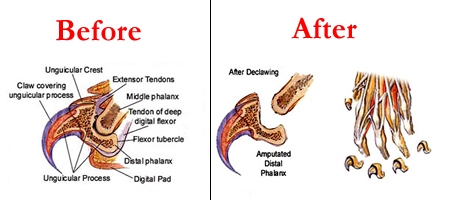
 According to prominent veterinarian Dr. David E. Hammett, DVM, "The consequences of declawing are often pathetic. Changes in behavior can occur. A declawed cat frequently resorts to biting when confronted with even minor threats. Biting becomes an overcompensation for the insecurity of having no claws. Bungled surgery can result in the regrowth of deformed claws or in an infection leading to gangrene. Balance is affected by the inability to grasp with their claws. Chronic physical ailments such as cystitis or skin disorders can be manifestations of a declawed cat's frustration and stress"
According to prominent veterinarian Dr. David E. Hammett, DVM, "The consequences of declawing are often pathetic. Changes in behavior can occur. A declawed cat frequently resorts to biting when confronted with even minor threats. Biting becomes an overcompensation for the insecurity of having no claws. Bungled surgery can result in the regrowth of deformed claws or in an infection leading to gangrene. Balance is affected by the inability to grasp with their claws. Chronic physical ailments such as cystitis or skin disorders can be manifestations of a declawed cat's frustration and stress"

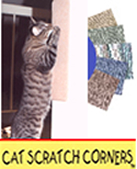 Cat Scratch Corners
Cat Scratch Corners
